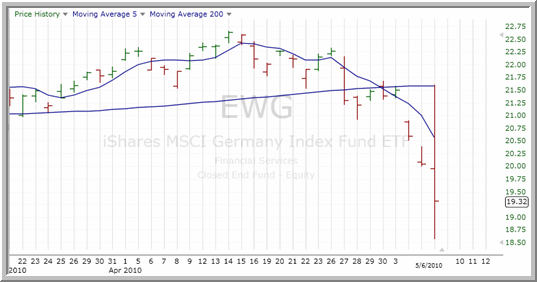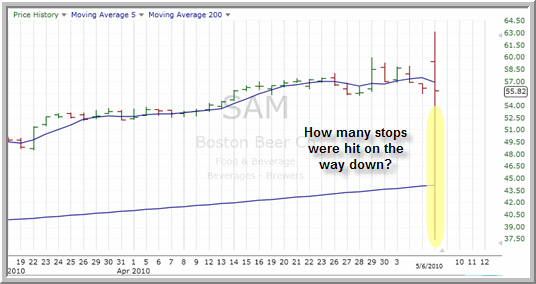High Probability Trading Report: Greek Debt, Goldman Sachs and Data-Driven Trading
As if the world hadn’t gotten complicated enough with global concerns growing over the economic (and political) situation in Greece on the one hand, and executives from the smartest firm on Wall Street on the hot seat before Congress on the other, traders have had to deal with some combination of errant button-pushing and high frequency trading routing re-directs that triggered a massive intraday sell-off in U.S. markets.
If you are a high probability trader – especially if you are a conservative one – then this sell-off (or at least something like it) may be what you have been waiting for. Conservative high probability traders, the kind of traders who only buy markets when they are radically oversold, have had relatively little to cheer about over the past several weeks, as the general bullish climate has meant that oversold markets have not remained oversold for long.

A large number of country-based exchange-traded funds have continued to move below their 200-day moving averages and should be avoided by high probability traders looking for quality pullbacks to trade. Pictured above is the ^EWG^.
This may have encouraged some high probability traders to become more aggressive and risk-seeking. Traders who only traded the blue chips of the S&P 100, for example, may have started to look at the smaller caps of the Russell 2000 for potential oversold stocks. Others who might have required particularly extreme oversold conditions before taking a position in an ETF may have accepted less oversold markets as “oversold enough” to begin scaling in.
Such strategies may be reasonable adjustments when volatility in the markets becomes persistently low. Such adjustments can help traders find trades during periods when there might otherwise be few – or even no – worthwhile trading opportunities.
But the problem comes when markets do sell-off powerfully like they did on Thursday. Our research indicates that the goal of high probability trading is to be taking on your largest positions when markets are at their most radical historical extremes and the edges, based on quantified testing, are at their greatest. This is the wisdom behind the aggressive versions of our high probability ETF trading strategies, for example, with the four-unit progressive scale-in of the TPS (Time Price Scale-In) Strategy being perhaps the signature example.

Above: Shares of ^SAM^ plunge intraday. As Larry Connors pointed out in the “Morning Market Commentary” of his Daily Battle Plan on Friday, market meltdowns like the one on Thursday are a reminder that stops are often not the best way to protect a position.
If you are a short term trader, then there’s a good chance that a part of you knows deep down that when markets are selling off, there are many smart and successful traders who are looking to buy. Professional traders call moments like these “following the playbook.” By “following the playbook,” traders mean many things. But typically those things boil down to a set of ready responses to data points quantifying changes in volatility, the transition from greed and complacency to panic and panic selling.
For many short-term, high probability traders, High Probability ETF Trading Software helps provide that playbook. Based on the 7 quantified, backtested strategies in the award-winning book by Larry Connors and Cesar Alvarez, High Probability ETF Trading, High Probability ETF Trading Software provides exchange-traded fund traders with high probability entries, the high probability scale-ins and the high probability exits based on thousands of simulated trades in widely-traded ETFs from the ^SPY^ to the ^XLF^.
Isn’t it time you gave quantified, data-driven trading a try? Click here to launch your free, 7-day trial to our High Probability ETF Trading Software today and make 2010 your best trading year yet.
David Penn is Editor in Chief at TradingMarkets.com.
